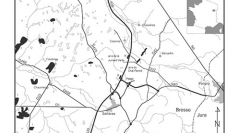

 Comptes Rendus Palevol
1 (4) - Pages 221-225
Comptes Rendus Palevol
1 (4) - Pages 221-225During the Tertiary, a thick sedimentary sequence was accumulated in the Bresse Basin, including some lignite that was locally excavated. Although the palynology of this lignite is relatively well known, the fossil plant macroremains were only poorly studied. Well-preserved material from a new Upper Pliocene (Reuverian) outcrop is reported herein. It allows for palaeoecological and biogeographical reinterpretation. The flora, which includes palm-trees and umbrella pine, is interpreted as a ‘Sequoia-Moor’, i.e. an acidophilic swamp-forest type that had never been evidenced from both micro- and macroremains in France.
palaeobotany, Late Tertiary,